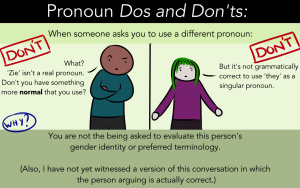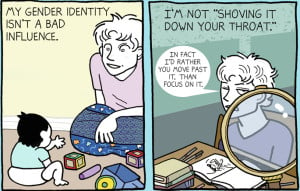I was seventeen years old the first time I was told I was going to be sterilized.
I couldn’t believe it. I knew rumors from other trans people that you might be sterile after starting Hormone Replacement Therapy (HRT), but I wasn’t informed it was going to happen.
The therapist I met had a huge list of Things to Consider before beginning HRT, but by far, sterilization was the one facet I could not grapple with at the time.
My whole life, I had dreamed intimately about being a mother.
My child would be a chubby Brown baby with dark brown eyes and a thick head of hair, with my DNA being part of the magic of this angel’s existence.
But that dream was cut suddenly short. This doctor told my seventeen-year-old self that I was going to be infertile a year into treatment.
The other option I was offered was to sperm bank my potential future babies. The price range I was given by the doctor was $500 for the initial freezing, and approximately $50/month to keep my sperm frozen.
I immediately knew that wasn’t an option, and that once again a financial barrier had come between me and my dreams. I left feeling defeated, like I had no choice but to start HRT quickly and figure out child creation later.
Before I could debate the dilemma further, I was informed I needed my mother’s consent to start HRT. When I asked her, she refused treatment and cut me off the family health plan.
Initially, I was incredibly angry that she became a barrier to HRT as well. Given more time to think about sterilization, I came to conclusion that it was too great a compromise to make. I dropped the idea of starting HRT.
Four years later, I found myself in a doctor’s office two days before Christmas asking for HRT. Still financially broke and unable to afford a sperm bank, I began HRT with a year promise to myself that if I didn’t like the effects, I would stop.
Since then, I have crossed the threshold of sterilization. I mourned the inability to have my own genetic children from my thousands of bloodlines, each radically entwined with Brown resistance.
I can’t have babies. And no one in the reproductive justice movement is talking about this.
It wasn’t until I watched Micha Cardenas perform about her pregnancy as a trans woman that I had a major breakthrough moment. It was – and still is – possible to become pregnant again.
What this means is that trans women who stop taking HRT for a few months can reverse sterilization and become pregnant with viable sperm.
In the audience, as Micha stood before her artwork and moving telescope images of her viable sperm, I cried whole-heartedly. She had been on HRT for many years and still was able to become pregnant.
This opened up a whole new realm of possibilities and hope. And joy! And happiness!
It also opened up volcanic anger. I spent many hours heatedly dissecting all the systems and structures in place that limited my knowledge and ability to create a family.
From this experience, I have compiled a short list to make changes in the reproductive justice movement to center trans women. Hopefully, with more education and a focus on trans women, many more women will not have to view HRT treatment as an ending to their family-making goals.
Hopefully, by educating and applying these tips to reproductive justice, we can open up many more possibilities to trans women looking to create families.
1. Affordable and Free Sperm Banking Options
From my experience, you can see how sperm banking was not an option within my financial means.
Unfortunately, many doctors, including the ones trained in transgender competency care, urge young trans girls to start HRT as soon as possible.
As a 21-year-old, I’m still being told by a doctor who’s seen dozens, if not hundreds, of trans patients to take the maximum dosage to get the “best results” – which essentially means “to look as cis as possible.” She recommended this after I shared my reservations around sterilization.
So, what can we do?
According to Planned Parenthood, birth control pills cost between $0-$50/month depending on an individual’s health plan. Fairfax Cryobank charges $40/month for sperm storage, after an initial consultation and standard processing and freezing cost of $500.
Though the costs are relatively expensive, the reproductive justice movement has fought tirelessly to make birth control affordable.
I’d like to see that same passion and dedication to providing trans women with reproductive options.
This looks like fundraising and organizing to change public policy to include affordable and free sperm banking options for trans women under health care plans, both public and private.
2. Protecting Trans Women from Violence
Morgan Robyn Collado inspired me to reframe reproductive justice to center trans women with her speech at the Civil Liberties and Public Policy conference.
Morgan states in this speech,
If trans women of color cannot reproduce because of the violence that we face, than it is a reproductive issue. If we cannot build the network of people and community that constitutes a family because of the transmisogyny we face, than it is a reproductive issue.”
Put simply, if we aren’t alive, how are we to create families?
The issue of violence against trans women is a state of emergency. In 2015 alone, over twenty trans women have been murdered, and at least fifteen of them were Black.
As clear as these murders are due to transmisogyny, they’re also greatly informed by misogynoir – the misogyny that specifically targets Black women.
This type of violence is rarely accidental. Many trans women are abused and murdered by their intimate partners, which makes protection from violence a more difficult task.
In order to protect trans women from violence, there must be an investment to combat anti-Blackness and transmisogyny within our own selves and our larger communities.
This means educating yourself on multiple feminist issues, supporting living trans women by employing us in sustainable careers, and calling out transmisogyny whenever it presents itself to change the current culture to one that humanizes us.
Until we’re seen as lovable humans with worth, we will continue to suffer extreme violence. And no one can create healthy, happy families under that circumstance.
3. Gainful Employment with Health Benefits
Ah, employment. Aren’t we all looking for that one job that fulfills all our needs that isn’t also soul-sucking?
Yes, we all are. And the ones least likely to get it is – did you guess it? – trans women.
Sure, this is kind of idealistic. But unless I set my aims high and my hopes even higher, I’m not sure half the amazing work I do would ever get done.
So please, help make this dream come true.
Give trans women the opportunity to fuck up, to grow professionally, to be taken seriously in a workplace.
Very few work environments support us learning to become better workers. Most places have incredibly high and sometimes unattainable qualifications for trans women.
For example, if I were to apply for a minimum wage retail job today, I may not be able to use my references because I was using my birth name and wrong pronouns.
Most places that I have looked into ask for at least a year’s experience, and though I have that from working at a few different stores, I cannot validate that work history without outing myself as trans (either to my new or previous employer).
What can be useful – and so incredibly relieving – would be to partner up with LGBTQIA+ organizations and advertise specifically towards trans women.
I don’t mean just minimum wage jobs. I mean careers where I can have a health plan and benefits that extend to my family, including an income lovely and large enough to support children.
Most professional positions for trans women that currently exist are within the non-profit sector. While the work can be passionate, it rarely offers all the necessary benefits to accommodate family creation and sustainability.
4. Trans-Specific Adoption and Fostering Policies
I will admit, I am not a policy-writer. However, I believe many exist out there in the ether of this vast reproductive justice movement, and you are needed to make structural change to support trans women in making families!
What these policies need to include is bias and sensitivity training to identify the ways people project transmisogyny onto trans women seeking to start families.
For example, the idea that trans women are child molestors is highly prevalent and definitely acts as a barrier for us to start families.
Having policies in place that specifically state non-discriminatory practices, along with adequate trainings to identify biases and educate about basic respect towards trans people, will greatly improve the chances of trans women being able to adopt and/or foster children.
Even better, having trans women on staff in these adoption and fostering agencies to work with soon-to-be trans mothers would be dreamy!
It’s absolutely crucial that we have someone to talk mother anxieties with. It’s already difficult enough navigating all the feelings around not being able to carry children, and the constant (fucked up) reminder that “real women” have menstrual cycles.
Having one person who can really hear and validate our mothering anxieties without denying us our womanhood is imperative to creating a culture of support for trans women’s families.
***
Historically, trans women have been at the forefront of liberatory actions and enacted incredible amounts of emotional and physical labor towards creating homes for youth.
Countless trans women have housed and fed homeless queer and trans youth, much like Marsha P. Johnson and Sylvia Rivera did with the STAR House.
The creation of Ball Culture “Houses” was another way that trans women created homes for Black and Brown queer and trans people of all ages to have a chosen family that loved and accepted them.
These alternative family structures are historically significant in liberation work. They are also ongoing in present-day organizations and shelters like Casa Ruby and Jazzie’s Place.
Supporting trans women in creating families is necessary for the reproductive justice movement. It is not sustainable, as we have seen with the closing of the STAR House and Transie House, to operate solely on a few individuals to provide for a large community.
If we have systems and structures in place to support us starting families, we can have fewer queer and trans youth shuffling through the foster care system or ending up on the streets.
I have a few more years before I’m ready to start having my own children, and I hope to see enough progress so I can have multiple options on how to go about starting my family.
This is a good starting point for you to take back to your reproductive justice work and start strategizing how to change your own communities to better support trans women.
[do_widget id=’text-101′]
Luna Merbruja is a Contributing Writer for Everyday Feminism. She’s the author of Trauma Queen, an intern at Biyuti Publishing, international sorceress of performance art, and co-coordinator of the 2014 International Trans Women of Color Network Gathering. She’s currently working towards her career as a sex and trauma therapist.
Search our 3000+ articles!
Read our articles about:
Our online racial justice training
Used by hundreds of universities, non-profits, and businesses.
Click to learn more





















